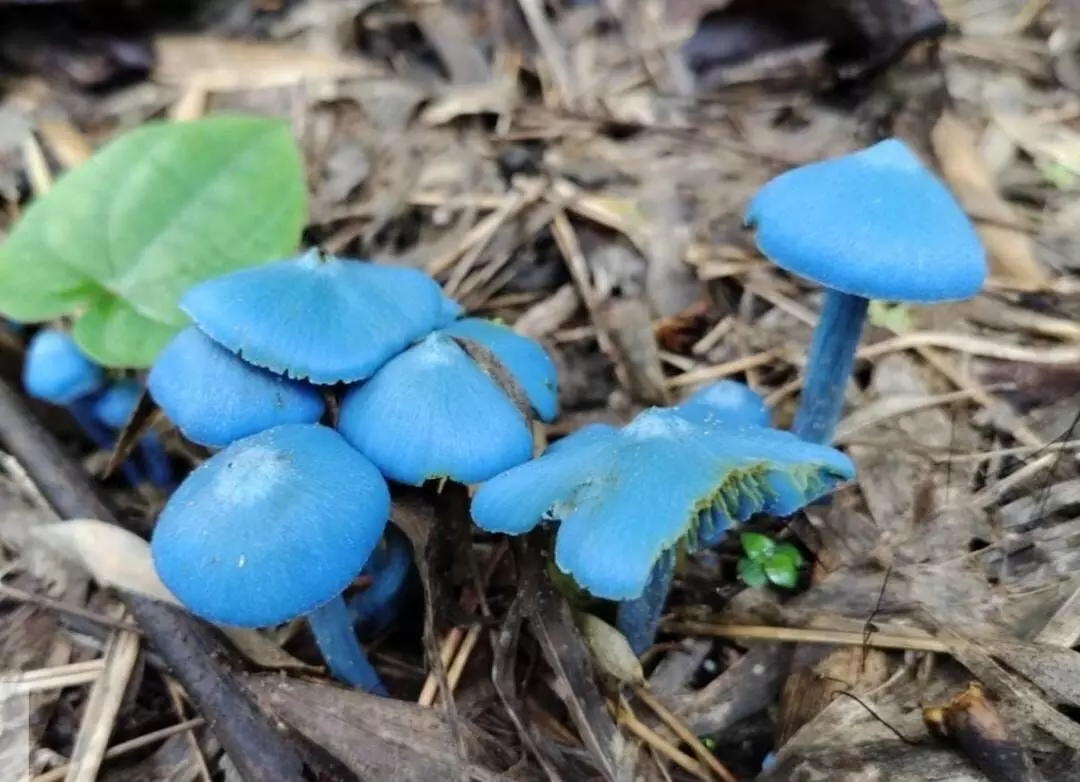Rare Blue Pinkgill mushroom spotted for the first time in Telangana forests
This visually enchanting fungus, also called the Sky-blue mushroom, has been spotted in the Komaram Bheem Asifabad district, marking its first-ever recorded appearance in the region,
By Nikisha Uddagiri
Telangana: For the first time in Telangana, nature has revealed one of its well-kept secrets in the forests of Vempally in Kagaznagar — a rare Blue Pinkgill mushroom — scientifically known as Entoloma hochstetteri.
This visually enchanting fungus, also called the Sky-blue mushroom, has been spotted in the Komaram Bheem Asifabad district, marking its first-ever recorded appearance in the region.
Similar excitement was witnessed in Odisha in 1989 when the enchanting Blue Pinkgill mushroom, was spotted for the first time in India, captivating the hearts of nature enthusiasts.
Also called Sky-blue mushroom or Blue Pinkgill (Entoloma hochstetteri), 👇this beautiful mushroom was noticed in Kaghaznagar Forest ( Maybe a first report from Telangana. Its first report from India was from Odisha in 1989.
— Mohan Pargaien IFS🇮🇳 (@pargaien) July 21, 2023
Thanks Neeraj Tiberwal DFO @kbasf_forest for images pic.twitter.com/e8HD6TdtUc
According to S Venugopal, a forest range officer of Kagaznagar, the discovery occurred during a routine stroll by forest watchers. "Its blue and unique form caught their eye and they sent me its picture,” said Venugopal.
Describing the mushroom’s allure, Venugopal said, “It’s not just the striking colour that sets it apart, but its mysterious behaviour too. The Blue Pinkgill mushroom glows at night, adding to its enigmatic charm.”
Originating from New Zealand, this extraordinary species holds the special distinction of adorning a banknote, the only one in the world featuring a mushroom — the $50 note of New Zealand. It has also been recognised as the National Fungus of the country.
Although there is no concrete information available regarding its edibility, as a general rule, attractive things in nature are often poisonous, warned officer Venugopal. He said, “The Blue Pinkgill mushroom appears during the monsoon when the forest cover reaches saturation due to abundant rainfall, which creates perfect soil conditions for mushrooms to grow and thrive.”
Emphasising the importance of preserving the natural habitat, Venugopal asserted, “Given the rarity of this mushroom, it is crucial to protect its forest ecosystem. Disturbing the habitat could have adverse effects on its survival. Our first priority should be to safeguard the forest ecosystem, and once a sustainable population is established, we can delve deeper into understanding this fascinating species.”
Credit to Telangana’s biodiversity
The discovery of the Blue Pinkgill mushroom in Telangana highlights the region’s rich biodiversity. Experts and nature enthusiasts are surprised by the presence of this exquisite mushroom in the forest.
Dr Jagadeesh Batthula, assistant professor at the Department of Forest Resource Management, Forest College and Research Institute in Mulugu, Siddipet, is intrigued by these fascinating mushrooms and their Avatar-like appearance.
“Entoloma hochstetteri is a fascinating and diverse group of mushrooms found worldwide. They come in various colours, shapes, and habitats, often referred to as ‘blue pink gills’ or ‘sky-blue mushrooms’ due to their pinkish to purplish gills. Some are small, with a distinctive all-blue colour and slightly reddish-tinted gills from spores, thanks to azulene pigments. They have caps that can be flat or funnel-shaped, pink or white gills and stems that may be centrally or laterally attached. The spore print is typically pink to salmon-coloured, which helps in identification,” said Dr Jagadeesh.
Explaining the role of these mushrooms in their habitats, Dr Jagadeesh said, “Mycorrhizal species form symbiotic relationships with trees by providing nutrients in exchange for sugars produced through photosynthesis. This mutualistic partnership benefits the mushrooms and the trees, enhancing the overall ecosystem. On the other hand, saprotrophic Entoloma species break down dead plant and animal material, contributing to nutrient cycling and soil enrichment.”
“While their toxicity level is unknown, it’s essential not to consume them as many Entoloma species are known to be poisonous. However, preliminary chemical analyses have shown that Entoloma species contains bioactive compounds with potent antioxidant and antimicrobial properties. These compounds could have potential applications in developing new drugs for various ailments, including infectious diseases and oxidative stress-related conditions,” Dr Jagadeesh added.